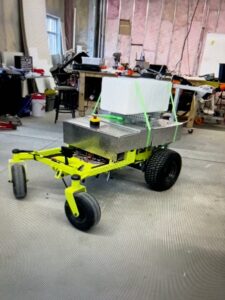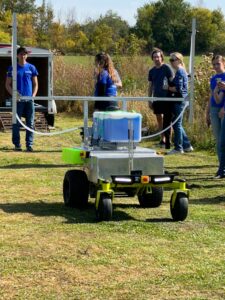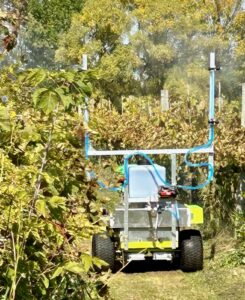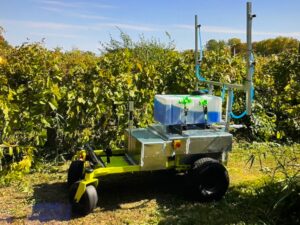Project Overview
Information Products
Commodities
- Fruits: grapes
Practices
- Pest Management: chemical control
Summary:
The vineyard canopy has been under attack by the invasive species, the Japanese beetle, for the last six seasons. The beetles attack the upper canopy starting from late June through early September. The canopy damage lowers grape quality, harvest yield, and causes uneven ripening of grape bunches.
We have experimented with milky spore along with grass and weed herbicide control to eliminate the vegetation between rows and under vines. Together they have lowered the number of beetles but not enough to improve overall production of grape quality and yield. We still have 20-30% canopy loss plus the canopy regrows first taking nutrition from the grapes.
A traditional tractor uses 25 gallons/acre vs. 2.5 gallons/acre using a drone, which in turn cuts down on environmental damage. Also heavy rains have not allowed a tractor sprayer to be run in the field. Drone spraying is not affected by rain.
I am proposing precision agriculture by using a drone sprayer system to control the beetle from overhead using 70% less pesticides, decreasing chemical drift and evaporation with greater adherence of chemicals to leaves and beetles on vines. I believe production can be increased by 150-200% through better control of the beetle using aerial spraying.
Update: 2/8/2021
Due to the COVID-19 Pandemic, supplies from China have been severely interrupted. The Joyance 10L Electrostatic Centrifugal Drone Sprayer and similar drones, for example, were unavailable in the United States during 2020. FAA rules and regulations are continuing to evolve regarding sprayer drones. Because I was unable to begin actual field trials no money from the grant has been spent. A website: vineyard.icecycle.com was created and continues to be updated.
In order to have an accurate baseline for the upcoming growing season and trials, I recorded chemical application (dates and field areas) as shown on the attached Japanese Beetle Control (Conventional Spraying) -2020 spreadsheet. Production in pounds for the ten rows of vines in full production is identified in the attached spreadsheet: Production 2020.
Objectives remain the same. In order to have two full growing seasons for research/trials an extension request will be forthcoming along with some budget adjustments.
Japanese Beetle Control (Conventional Spraying)--2020 - Sheet1
Production September 2020 - Sheet1
Update 1/1/2022
Due to pandemic shortages and ever changing government regulations it will take two to three years to receive certification from the FAA to use an aerial drone sprayer. I plan to change to a ground based robotic drone sprayer. Aerial sprayers can reduce the use of chemicals by 70% over conventional broadcast spraying. According to Precision Agriculture Technology for Crop Farming (Washington State University), a ground based robotic drone can use 90% less pesticides to achieve similar efficiency to conventional broadcast applications. A ground based robotic sprayer will offer safety for the operator as well as the environment as in my original proposal.
On July 7, 2021, I received approval for an eleven month extension of the grant and a change to a ground based drone. The Ryobi platform was purchased in July 2021.
Purchased the electrostatic ULV Fogger sprayers in June and late August (second fogger was out of stock until August 22, 2021).
Japanese Beetles arrived unseasonably early in 2021 (June 24th) and died out early by August 11th, so I was unable to begin testing the ground based sprayer. I am able to design the mechanical and pumping systems.
The sprayer must be able to navigate a 500 foot plus vineyard row, which is nine feet on center with a eight foot wide lane down the center of the row, with end rows 25 feet wide. One acre of vineyard is roughly ten rows wide. The vehicle will need a RC and “Follow Me” Bluetooth or WiFi IPhone mode of control, along with the autonomous mode, after being unloaded in vineyard. The goal is to spray at least three acres per battery charge. SAFETY SHUTDOWN SYSTEM IS REQUIRED.
I will be providing the 48 volt, 100 amp, main battery power vehicle framework with a 42 inch mower deck (Ryobi ZTR Mower). This platform can be modified to become an autonomous sprayer. Also, included are two electrostatic sprayer units which operate on 48 volt battery packs. These units can be modified and integrated into the robotic vehicle systems with end row shutdown during turns. A sprayer reservoir tank may be needed to meet spraying requirements. It is up to the design team to decide.
Japanese Beetle Control (Conventional Spraying) 2021 - Sheet1.pdf
Update: 3/1-12/31/2022
Plans fell through for the autonomous drone sprayer to be part of senior engineering projects at South Dakota State University (SDSU) in January 2022. Instead the Robotics Team at SDSU took over the project in March 2022 when the base platform was shipped to SDSU. I’ve included my original design/concept of the sprayer which was shared with the club.
Twenty-three students have been working approximately five-six hours each per week with a break over summer. Progress on the autonomous sprayer includes a cover to waterproof the electronics and connect to the batteries. Sprayer arms were made and attached onto the platform. CPU board was added to the sprayers to be controlled by remote control. Emergency stops and obstacle detection sensors were added.
On Oct. 2, 2022 a Field Day was held to demonstrate and test the remote control autonomous drone sprayer. Included are images from the Field Day. Also see the grant website for additional images and videos of the sprayer in action.
Ideally the autonomous sprayer would have been ready earlier in the season for testing against the Japanese Beetle but 2022 was an unusual year for the Japanese Beetle. Because of the drought the beetle only appeared for approximately three weeks with very little damage to the vine leaves. The damage was limited to the first few rows to the east and west ends of the fields and along the north/south edges of the fields (in about six plants). See the vineyard, production, and spraying attachments for 2022. This information shows the limited appearance of the beetle and limited need for spraying. The vineyard map shows the location of the vineyard rows within the entire Natzel farm and the specific location of the rows in the grant.
Note that because of the drought and high temperatures Frontenac Gries production was lower compared to prior harvests. Marquette production on the other hand was considerably higher due to the summer temperatures and lack of water and limited beetle damage. Other Minnesota vineyards experience the same results–especially the bumper Marquette crop.
Enhancements to the autonomous drone sprayer will continue. Two cameras, a lidar sensor for obstacle detection, and GPS software so the sprayer will drive by itself will be added in 2023. The vineyard.icecycle.com website will provide updates as the project progresses.
Production 2020, 2021, 2022. Sheet 1
Japanese Beetle Control (Conventional Spraying) 2022
Project objectives:
The objective is to lessen pesticide usage to control the Japanese beetle which in turn will do less environmental damage to soil, water, animal and human life.
The speed of the drone, the spray amount, the drone altitude and the ratio of pesticide to water mixture will be controlled. Drone use will speed up spraying the 12 acres, which will lessen the health risk from chemicals on the sprayer operator along with less pesticide drift by using 90% less liquid.
Another objective is to reduce the vine canopy beetle damage caused by the Japanese beetle in order to increase production.



